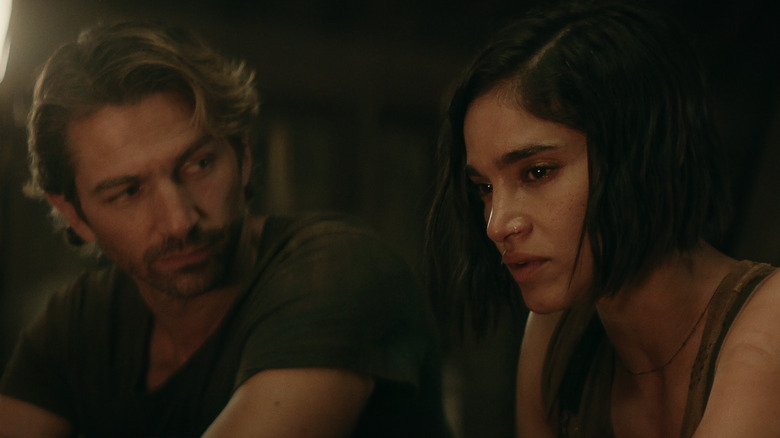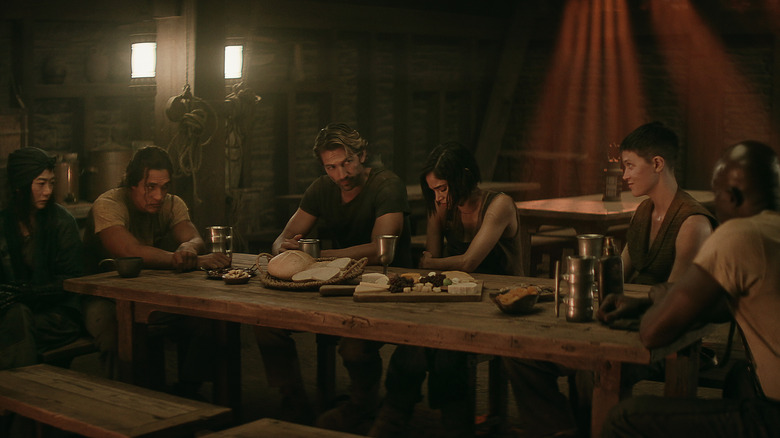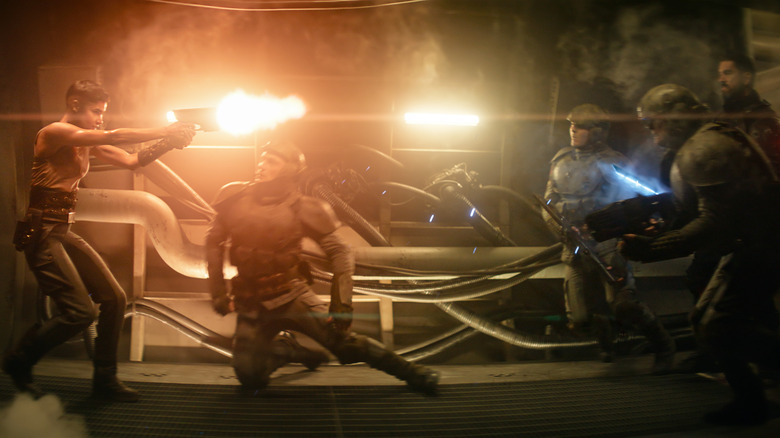Rebel Moon: Part Two Review: When Peak Zack Snyder Meets Peak Netflix, We All Lose
A new movie just came out from Zack Snyder, the divisive but provocative director who has inspired legions of passionate and loyal fans online, but it hardly feels like anyone outside of the internet knows or even cares much. Perhaps that's the peril of falling into the streaming trap, where name-brand talents receive sky-high budgets for productions that no traditional studio is willing to support ... only to be promptly forgotten once its brief time in Netflix's weekly Top 10 reports comes and goes. Full disclosure: It's downright strange to have been able to see "Rebel Moon: Part Two – The Scargiver" in a theater and base this review on that experience, particularly when the vast majority of those reading this will never have the same opportunity. Yet it's stranger still that the film we've received, from a visionary auteur whose battles with corporate overlords during his tenure in the DC world are the stuff of legend, seems to finally give in and embrace the algorithmic futility of it all.
Where the first "Rebel Moon" plays out like a one-note exercise in repetitiveness, "Part Two" is really more like two separate features smashed into one — the first of which is vastly more compelling (and, most intriguingly, completely unlike Snyder's typical go-for-broke M.O.) than the second. Some may be tempted to call this effort an overall improvement since, for all its problems, at least the sequel functions as an actual movie this time around as opposed to an extended series of video game cutscenes. And unlike the drowsy results of the previous would-be "Star Wars" story, this latest space opera provides flickers of hope that Snyder has managed to sneak something unique, restrained, and utterly counterintuitive through the Netflix gatekeepers. Those hopes, unfortunately, are ruthlessly snuffed out once the latter half of the movie arrives and all but pummels viewers into mindless submission — courtesy of a nearly hour-long, dramatically inert action bonanza calling to mind the last act of Snyder's "Man of Steel" or, even worse, the entirety of "The Hobbit: The Battle of the Five Armies."
On one end, the quiet and (relatively) character-focused beginning still feeds into "second-screen content," the insidious idea that subscribers can tap out and disengage from a narrative just enough to keep their Netflix app running. On the other extreme, the tsunami of sound and fury taking us to the end credits almost feels designed for viewers to skip ahead and indulge in the shoot-'em-up spectacle our dopamine-starved brains have missed. Here, "Rebel Moon: Part Two" pulls off its most dubious achievement: abiding by the streaming giant's arbitrary mandates (the final, too-tidy runtime of two hours and two minutes is yet another capitulation to the almighty algorithm) while still remaining an experience that only Zack Snyder could unleash.
Neither of these elements, however, makes for a satisfying watch.
Trying something new
For the first 45 minutes or so of "The Scargiver," I was ready to eat my words. Sure, the sequel inevitably lives up to the "Part Two" in its title, hitting the ground at a full sprint and picking up exactly where the previous film left off as rebel leader Kora (Sofia Boutella) and her merry band of misfits return to the moon of Veldt after their triumph over the sinister Admiral Noble (Ed Skrein). But even if the cutoff point between installments makes for an awfully unwieldy structure — there are essentially only two vaguely defined acts in this movie — the screenplay (credited to returning co-writers Snyder, Kurt Johnstad, and Shay Hatten) at least has the presence of mind to zig when most viewers would expect it to zag in the early going.
Viewers anticipating a time jump and some bombastic set piece to kick things off instead are treated to something much more refreshing: a prolonged calm before the storm. This setup not only puts faces and names to the otherwise anonymous villagers who make up Veldt (thus providing emotional stakes), but it also allows time and space for all the character-building, thematic touches, and even instances of humor and heart that "Part One" never once bothered to establish. One-dimensional warriors who'd hardly spoken a word to one another previously, like Staz Nair's perpetually shirtless Tarak and Djimon Hounsou's General Titus, share meaningful moments and get to establish their own personalities. Otherwise stoic characters such as Doona Bae's Nemesis and Elise Duffy's Milius finally show their humanity as they laugh, cry, dance, and even sing in one especially moving sequence.
One scene sums up this double-sided sequel best. Somehow both oddly effective and egregiously clunky at the same time, our main protagonists sit around a table and literally recite their backstories and personal histories to one another — kind of like high school drama students suffering through icebreaker activities on the first day of class. No doubt, it would've been nice to know their various motivations the first time around and in a more elegant way than ham-fisted flashbacks. (For those waiting to find out exactly why Kora's been a fugitive from the Imperium all along, this sequel has the longwinded and long-overdue exposition dump for you!) For once, however, the camaraderie and charisma we've only ever been told about among this talented cast genuinely shine through.
There's no denying the wonderful sense of earnestness on display which suggests Snyder, despite his edginess and too-cool-for-school façade, might actually be a bit of a softie deep down inside.
Going back to the same old thing
Of course, the good times can't last — both for those stuck on Veldt and for those of us professionally obligated to keep watching "Rebel Moon" beyond this point. Confidence in victory lasts for approximately ten minutes of screen time for our conquering heroes, who quickly realize the Imperium intends to return to Veldt in only five days rather than retreat to the Motherworld. Bizarrely, the rebels remain under the impression that their enemy simply wants to collect the grain they were owed from the first film, rather than exact fiery vengeance upon the insurgents responsible for their humiliating defeat the last time around. (This misunderstanding is just one of the script's many missed opportunities, as it shows absolutely zero interest in exploring such dramatic irony.) Admiral Noble, who did NOT die and has a nasty mark from the eponymous Scargiver to show for it, obviously has other ideas.
But as the film drags on and goes all in on its "Lord of the Rings" war ambitions, any and all of the goodwill generated by the first hour of "Part Two" is replaced by some of the most peak Zack Snyder moments in his entire filmography. Prior attempts at making us invested in our heroes give way to thuddingly rote clichés, where impromptu haircuts and shaved beards (possibly the only real "arc" that Michiel Huisman's Gunnar ever receives, alongside his unconvincing romance with Kora) and inspiring speeches full of empty words are meant as stand-ins for character development. Snyder once again displays his usual knack for crafting the occasional breathtaking visual and colorful splash page — a kiss silhouetted by the Veldt equivalent of magic hour, a spaceship foregrounded by an eclipsing star, and a stunning tableau of lasers crisscrossing in the heat of battle are memorable highlights — but his insistence on serving as his own director of photography continues to hold him back at every turn. By the time war breaks out between the rebels and the Imperium and the body count stacks up, not even Tom Holkenborg's pounding score (complete with his own overused answer to Hans Zimmer's "Wonder Woman" theme) or one legitimately inspired, gravity-defying duel between Noble and Kora can save this venture from Snyder's worst tendencies.
Worst of all, this endless action sequence builds to less of a conclusion and more of an anticlimactic jumping-off point for "Rebel Moon: Part Three." Last year, I wrote that "Part One" ended on a threat. Here, the sequel can't even inspire a similarly strong reaction. We're all Kora, forever caught between two competing forces. Ours, unfortunately, happens to be between the machinery of the streaming industry and the whims of a visual artist who could be so much more than that.
/Film Rating: 4 out of 10


